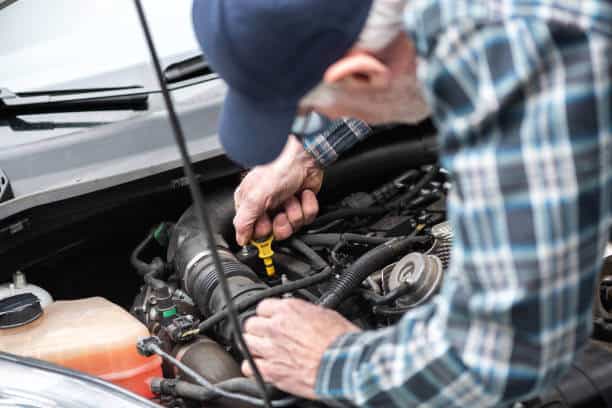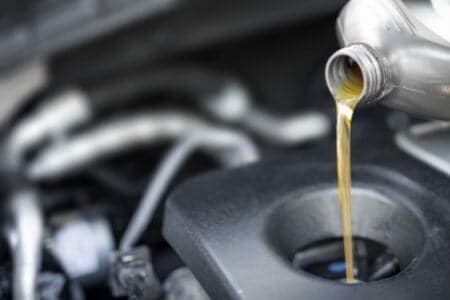Car oil is used to lubricate the car’s internal engine to reduce wear and tear on the engine in motion. Most of the car’s oil levels are read manually using a dipstick after getting under the bonnet. In contrast, some cars have electronic monitors that automatically show oil level on your dashboard.
Further, it cleans the motor engine from any slush and cools the engine by removing excess heat from the car moving parts. Finally, the motor oil covers metal parts keeping them from oxidation after being exposed to oxygen. You must have the correct oil amount to avoid distorting your car engine.
Refilling your car engine with oil does not require a mechanic as long as you know the steps to follow in carrying out the activity. You can also change your motor oil and get rid of the old oil. Although motor oil is beneficial, it also has its environmental effects and therefore handling it requires carefulness. For instance, the effects include air pollution.
How to check the oil level

Step 1: Leave your car to settle for some time that is around 5 minutes
Check your oil level after leaving it to settle while following the manufacturer’s manual instructions.
Step 2: Press the button to open the hood of the car
Search between the hood and the car body to find a small lever and then press it firmly in the inside direction to unlock the hood.
Step 3: Find the location of the car dipstick
The car dipstick is a metal that is very long and extends to the oil pan. Find its location, which is at the front of the car. Its handle is colored for you to locate quickly.
Step 4: Remove the dipstick and clean it using a clean cloth
When driving, oil splashes over the dipstick and it must be cleaned thoroughly. After cleaning it, return it to get the best oil level readings.
Step 6: Return the dipstick back and again get it out to check the oil level
After removing the dipstick again from the oil tank, read the readings to know if you need to add oil or you do not need to add oil.
How can you refill your car motor oil?

Step 1: Open the dipstick and remove it.
Remove the dipstick and clean it using a clean towel, put it back and again draw it out. Check the amount of oil remaining on the dipstick, whether it is complete or low. If the oil level is beneath the full line, add more oil and if there is no oil on your dipstick, consult a mechanic.
Step 2: Pull the oil cap found on the car engine
After removing the oil cap, take a clean funnel and place it in the car engine. If you were driving, you must wait for 5 to 10 minutes until the engine cools down and the oil settles. Proceed to add oil to the tank.
Step 3: Replenish the engine with oil
Pour oil for around 2-3 seconds in the dipstick and wait for a minute. Then check if the port is filled up. Consider the amount of oil you require to fill your dipstick. For instance, two-quarts of oil are required to fill the dipstick. If the level falls between the “add” and “full” mark, the amount of oil required is ½ quarter. While adding oil, ensure that you don’t overfill the container. Wait for the oil to settle for 2 to 5 minutes.
Step 4: Close up your dipstick
Close your oil fill cap after checking if it is complete.
Step 5: Turn on your car engine to see if it works
Try to start your car engine and leave it to run for a few seconds. If it fails to start, recheck the dipstick to confirm if it is appropriately cleaned and then check if the oil you put reached the correct level, meaning you did not over refill the dipstick.
When gilling the dipstick, you must ensure that you pour oil slowly to prevent oil leakages, hold your funnel firmly to avoid pouring oil everywhere and finally ensure that the oil is warm before filling the dipstick.
Changing your car oil

Changing the car oil improves the performance of the car engine and prolongs its life span. It also saves you money which you would have needed to repair or replace the car engine. Before you change your car oil, ensure that you have all the correct equipment required, such as funnel, motor oil, gloves. You must also buy the correct oil for the vehicle.
Step 1: Put on safety accessories
Safety equipment such as protective gear like gloves is required to prevent injuries.
Step 2: Drive your car through the ramps
Park your car in a dry place. Drive it slowly onto the ramps, use the emergency brake, and then park it and ensure that the ramps are in position.
Step 3: Remove the drain plug after locating it
Loosen the drain plug slowly and carefully. Eradicate it from the socket and slowly turn anticlockwise. Once you have removed it, also remove the plug gasket for the oil to drain.
Step 4: Return the drain plug slowly
Drain the oil from the oil port for several minutes until the port is empty. Return the drain plug slowly in the clockwise direction. Install the plug gasket while following the manufacturer’s instructions.
Step 5: Find the position of the oil filter and remove it
Locate the oil pan and place it directly under the oil filter and fit the filter wrench correctly in the oil filter. Untighten the oil filter counterclockwise direction, leaving it to drain all oil for a few seconds.
Step 6: Reinstall a new oil filter
Install the new oil filter and fit the oil filter wrench on the new oil filter and clench it clockwise.
Step 7: Fill in new oil to the oil pan
Unlock the car hood, remove the engine oil cap and then pour oil through the funnel you fitted slowly until complete. Coat the engine oil cap with oil and place it back to its position in the clockwise direction.
Step 8: Dismantle the emergence breaks and drive off the ramps
Drive your car in reverse motion off the ramps ensuring that the car is still on a dry flat surface.
Step 9: Check for any oil leaks
You can now start your engine and leave for up to 2 minutes. During this period, check for any oil leakages and fix them by shutting the engine if any leakages are found.
Step 10: Clean up all parts and reuse the oil
Get rid of all used oil filters, used magazines, or cloth used appropriately. Further, you can reuse the motor oil after taking it to the recycling places.
Conclusion
Car oil needs to be frequently refilled and changed to protect the engine from any breakages. From the article, you now understand how you can check your oil amount, fill your oil pan, and change the oil. Instead of looking for a mechanic to carry out the work, you can try yourself with a lot of carefulness. It is good to keep checking your car oil frequently to get an accurate reading and proper engine functioning.
